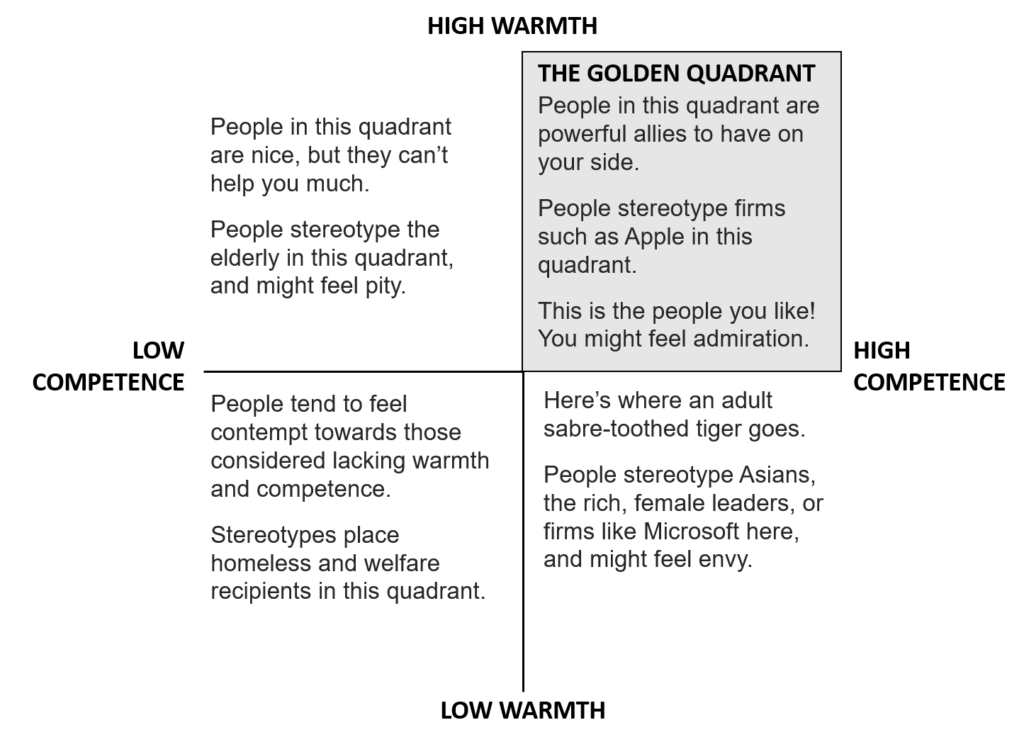Go to the Golden Quadrant
Episode #2 of the course How to be popular and have everyone like you by Sofia Santiago
Welcome back! As promised, today, I’ll teach you the most powerful (yet barely known) technique to be a people-magnet: going to the Golden Quadrant.
Before I tell you about it, though, I want you to imagine you’re a caveperson. One day, you hear a noise coming from the bushes behind you. You stop abruptly what you’re doing, stay still, listen attentively, and realize that there’s a living “thing” there. By now, you’ve learned to categorize beings into “those who want to harm me” and “those who don’t want to harm me,” as well as into “beings that can harm me” and “beings that can’t harm me.”
I don’t know if as a caveperson, you’re aware of how you look, but you’re likely aware of how your buddies look, so if the “thing” looks similar to them, you can relax. So, you first rapidly evaluate the thing’s “warmth” (or friendliness toward you).
Then, you assess its “competence” or ability to harm you. What if the “thing” is a lost saber-toothed tiger cub? It might want to eat you, but the cub wouldn’t pass the “competence” test because it can’t act on its intentions.
This is the minimum information-processing ability that a caveperson’s brain needed: Those who were able to quickly distinguish friends from competent or incompetent foes were the ones who survived. (So did the ones who snuck up on competitors with a big rock while they were sleeping. It was rough back then.)
Today, over 200,000 years later, you still (consciously or not) use the same two dimensions—warmth and competence—to evaluate others, develop feelings toward them, and interpret their behavior.
Equally important, others use those same dimensions to judge you.
Examples of warmth-related traits are compassion, friendliness, trustworthiness, kindness, and empathy. Examples of competence-related traits are intelligence, efficacy, skill, power, leadership, and assertiveness.
Warmth, Competence, and Likability
Based on the two dimensions of warmth and competence, individuals can be perceived as being in one of four categories (quadrants in the illustration below). Researchers from Harvard Business School have described these categories and determined the feelings that people tend to have toward people in each one of them.
So, what feelings would you like to inspire in others: pity, contempt, envy, or admiration? Admiration, of course! That’s why you want to be in the Golden Quadrant.
In general, given the choice, people pursue relationships with individuals who are high in warmth and competence. While research shows that likability is more dependent on warmth than on competence, in order to be more popular, you need to focus on cultivating both dimensions and balancing them.
Let’s look at John as an example.
John is a positive person who tends to see the good in others. He’s not judgmental but compassionate: He donates a few hours every other Sunday to visit inmates at his local prison and bring them emotional comfort and hope. He smiles often, laughs often, plays with children at every opportunity, and helps others whenever he can. He’s a warm guy.
John also displays competence by being responsible and ethical and in his own words, striving to be a “modern Renaissance man” (someone with a wide range of interests, especially in the arts and sciences). People gravitate toward John because they like him and know that his advice can help them.
John also knows to both downplay and overplay his warmth and competence.
Research shows that people actively downplay their warmth in situations where they want to appear more competent and downplay their competence in situations where they want to appear warmer. For instance, you might want to be perceived as a warm person at a kid’s birthday party and be perceived as more competent during a difficult negotiation.
Practice
1. Self-assess your warm and competence. Which one(s) would you like to develop?
2. Do you consciously emphasize one dimension over another to adapt to the circumstances, or are you usually the same you?
3. Consider two people you know—they could be coworkers, relatives, or celebrities. In which quadrant would you place them? Why?
In the next two episodes, you’ll learn techniques to go to the Golden Quadrant by projecting warmth and competence through your actions, words, and body language.
See you tomorrow!
Sofia
Recommended book
Share with friends


